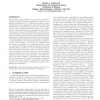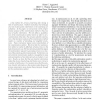1599 search results - page 180 / 320 » Theoretical Frameworks for Data Mining |
PKDD
1999
Springer
14 years 1 months ago
1999
Springer
When mining a large database, the number of patterns discovered can easily exceed the capabilities of a human user to identify interesting results. To address this problem, variou...
KDD
2004
ACM
14 years 9 months ago
2004
ACM
Kernel k-means and spectral clustering have both been used to identify clusters that are non-linearly separable in input space. Despite significant research, these methods have re...
KDD
2003
ACM
14 years 9 months ago
2003
ACM
Two-dimensional contingency or co-occurrence tables arise frequently in important applications such as text, web-log and market-basket data analysis. A basic problem in contingenc...
PKDD
1999
Springer
14 years 1 months ago
1999
Springer
: For many KDD applications finding the outliers, i.e. the rare events, is more interesting and useful than finding the common cases, e.g. detecting criminal activities in E-commer...
ICDE
2007
IEEE
14 years 10 months ago
2007
IEEE
A key method for privacy preserving data mining is that of randomization. Unlike k-anonymity, this technique does not include public information in the underlying assumptions. In ...


